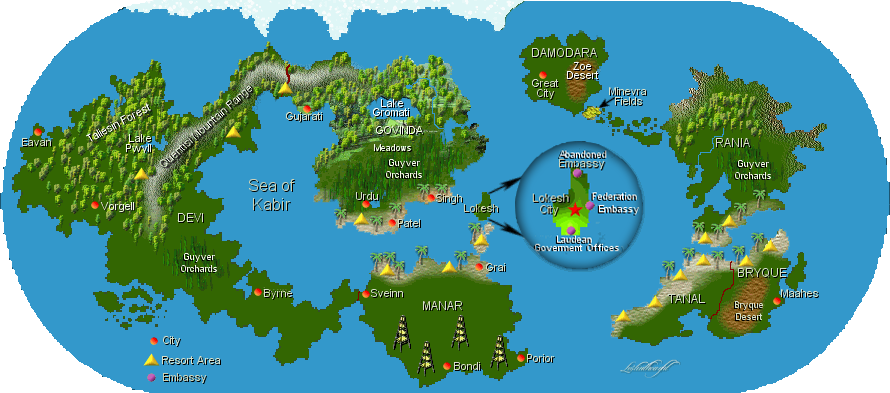Duronis II: Difference between revisions
No edit summary |
(deadlink removal) |
||
| (One intermediate revision by one other user not shown) | |||
| Line 74: | Line 74: | ||
** '''The [[Ikebana Rift]]''' | ** '''The [[Ikebana Rift]]''' | ||
*'''The [[Quentisi Mountain Range]]''' (Devi) | *'''The [[Quentisi Mountain Range]]''' (Devi) | ||
*''' | *''' The Forest of Alamak'ut''' (Govinda} | ||
*'''The | *'''The Farm Lands''' (Govinda) | ||
*'''[[Lake Pwyll]]''' (Devi) | *'''[[Lake Pwyll]]''' (Devi) | ||
| Line 111: | Line 111: | ||
[[Category:Galactic Atlas]] | [[Category:Galactic Atlas]] | ||
[[Category:Laudean]] | [[Category:Laudean]] | ||
[[Category:Federation | [[Category:Federation members]] | ||
[[Category:Homeworlds]] | [[Category:Homeworlds]] | ||
Latest revision as of 11:50, 23 May 2020
| Stellar Cartography |
|---|
| Galactic Atlas • Campaign Regions • Spatial Regions • Star Systems • Nebulae • Star Charts |
Luxis II or Duronis II, called "Til'ahn" by the native Laudeans, is a lush, verdant Class M world just outside of Federation space on the far side of the Typhon Expanse. Its star system also borders near the Zalkonians and the Romulans. Home System
Home World
EnvironmentTil'ahn is a Class M world approximately 14,000 kilometres in diameter at its equator, making it slightly larger than most Class M worlds (such as Earth). Its atmosphere contains the oxygen-nitrogen mix typical of such worlds, without major concentrations of other gases or even, at this stage in its history, much in the way of greenhouse gases or other pollutants. The inhabitants of some other "highly civilized" worlds envy Til'ahn's fresh, clean air. In fact, Til'ahn could be considered a model Class M world. Unlike worlds on the fringes of the Class M category, it has a wide variety of ecologies and environments. As a traveller moves from the ice-covered polar regions towards the equator, he passes through northern temperate, temperate, subtropical, and finally tropical regions, each containing its own distinctive flora and fauna. In some regions geographic and atmospheric conditions have conspired delightfully to create pockets of unusual climate or wildlife, further enhancing Til'ahn's biodiversity. ClimateThe planet's climate mirrors this environmental variation. Although it has an average temperature of approximately 21º Celsius, the actual temperature differs wildly based on the location and the season; Til'ahn has its beautiful, sunny days, swelteringly hot days, and bitter, grey winter days. It also has generous rainfall - an average of over 120 centimetres, with some tropical regions getting much more. Thunderstorms occur frequently during the summer months, and in the flatter regions of the temperate zones, tornadoes can also develop during that time. Due to the fact that it only has one large ocean, Til'ahn experiences few hurricanes or typhoons (kel'thrar, in the Laudean language); only the western coasts of Rania and Tanal suffer from them. Sometimes one of these fierce storms squeezes through the Terelix Straits to devastate the northern coast of Bryque before it plays itself out. Other Information
LocationsPhysical Map of Planet
Place NamesA large majority of places named on Duronis II are based on: Laudean Naming Conventions eg. Govinda is Hindi as is Lake Gavinda. The Mishai Resort is a beautiful span of beach 2 kilometers outside of Pital that boasts the whitest beaches and the clearest of waters. Sporting a Myco-dynamic scatter field generator, the beach is covered by a particle diffusing field that allows non-indigenous species to be able to enjoy the sunlight without the need of protective lenses. The Imperia Solorum was started by brothers Glak and Boruk in the beginning of the Laudean Tourism boon in 2377. An impressive 127 floor skyscraper with the most exquisite restaurant at the top, it has become one of the most popular attractions on the planet. Considered exclusive with a rich taste and a boast of all non-replicator food and drink, authentic Laudean and Duronis Sector entrees, the Imperia Solorum is a must visit for those who wish to dine in high culture. Features of Duronis II's Planetary Geography
Geographical/Topographical Details:
The land masses of Duronis II are divided into Provinces, each with its own Governor. (Formerly these were Kingdoms with Monarchs.) Each Province is also divided into political regions. Seven provinces/kingdoms divide approximately 98% of the Til'ahn landmasses. The remaining 2% exists as unclaimed or uninhabitable lands, such as the northernmost tundra.
|






